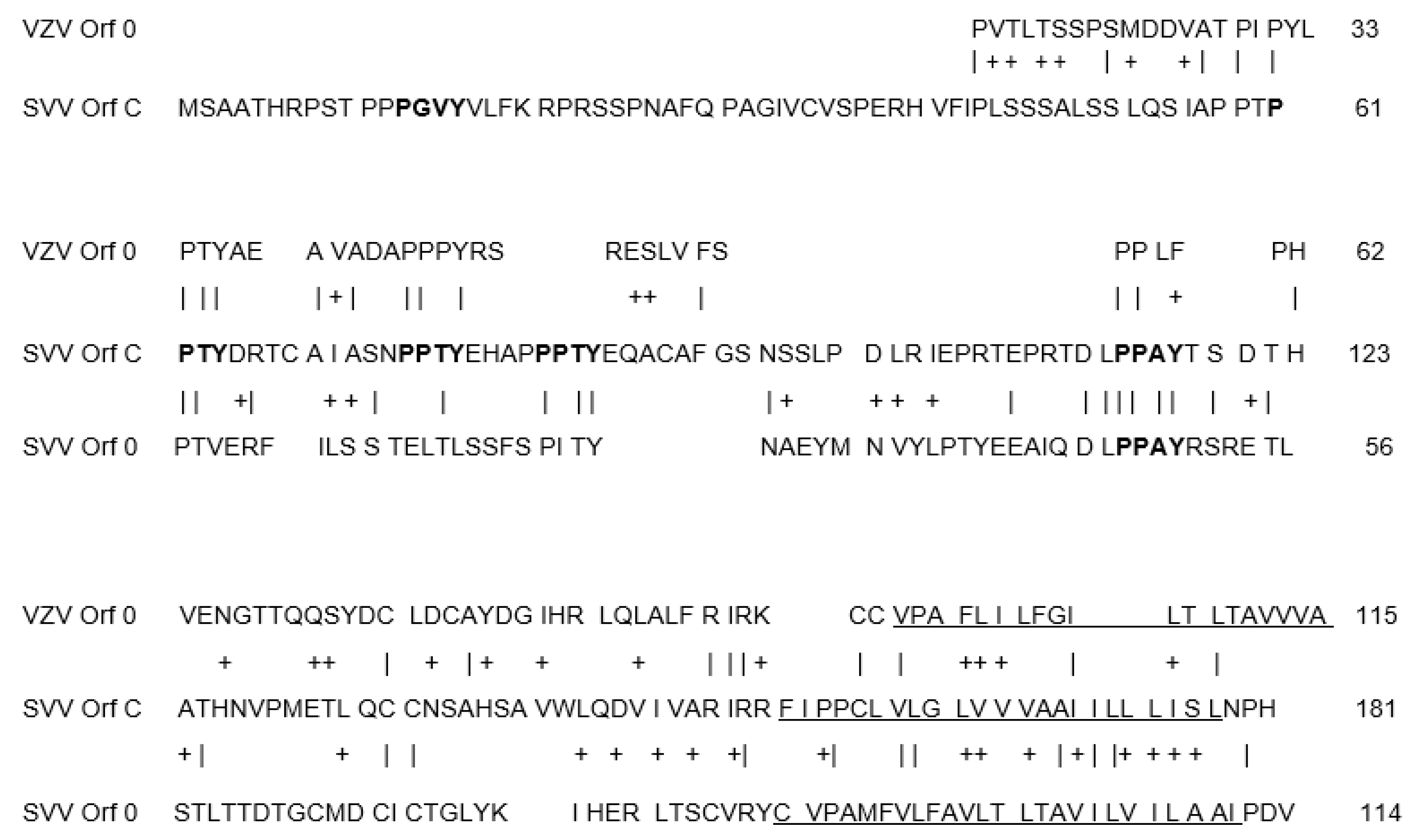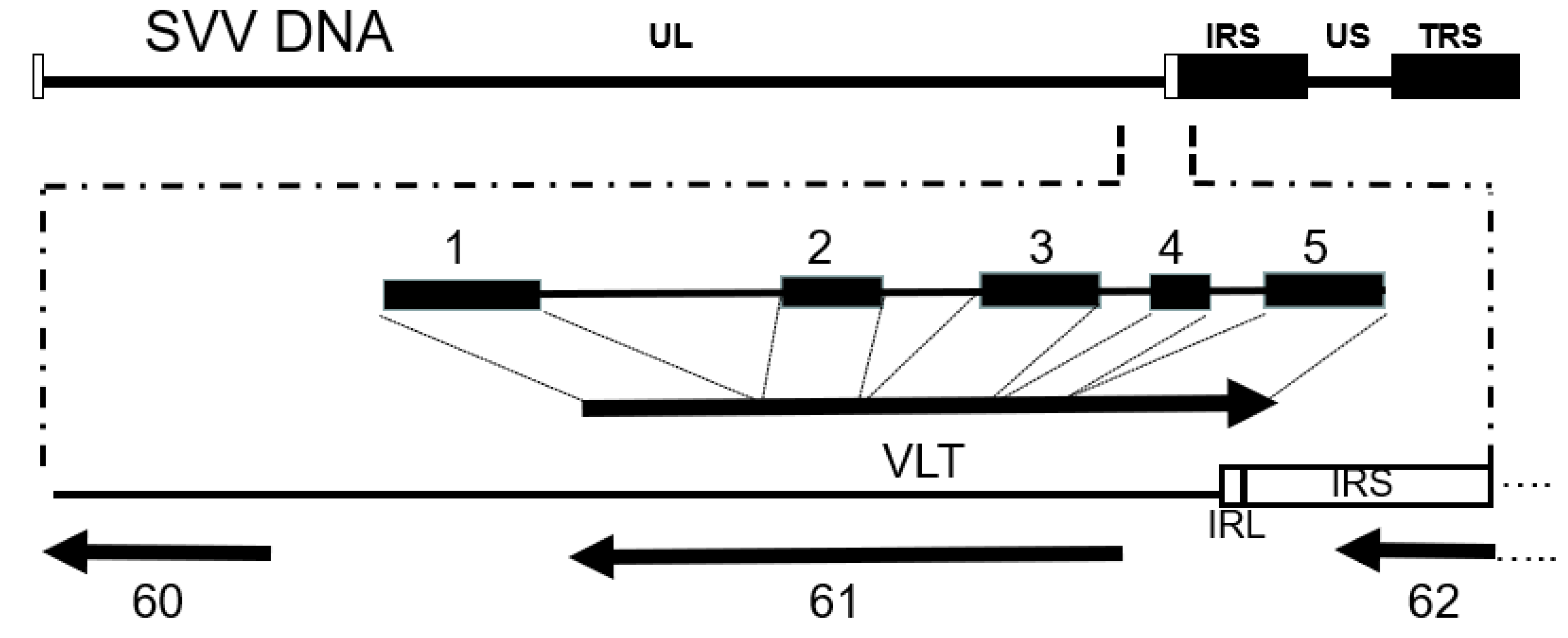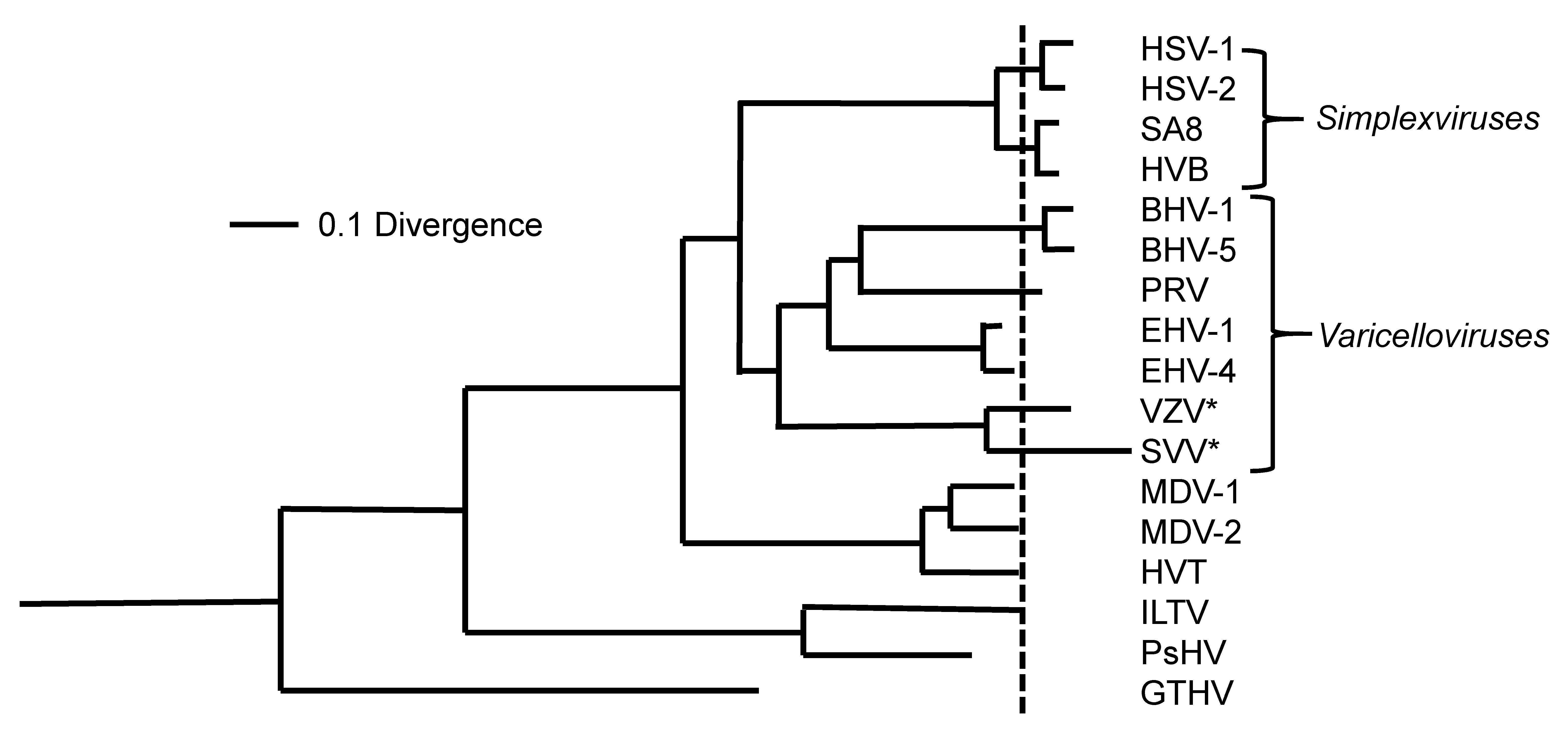Comparative Analysis of the Simian Varicella Virus and Varicella Zoster Virus Genomes
Abstract
1. Introduction
2. Size, Genetic Content, and Structure of the SVV and VZV Genomes
3. Gene Organization of the SVV and VZV Genomes
4. Transcription of the SVV and VZV Genomes
5. Regulation of Gene Expression of the SVV and VZV Genomes
6. Expression of SVV and VZV Viral Latency Associated Transcripts (VLTs)
7. Evolutionary Relationship between SVV and VZV
Supplementary Materials
Funding
Acknowledgments
Conflicts of Interest
References
- Kennedy, P.G.E.; Gershon, A.A. Clinical features of varicella-zoster virus infection. Viruses 2018, 10, 609. [Google Scholar] [CrossRef] [PubMed]
- Gray, W.L. Simian varicella: A model for human varicella-zoster virus infections. Rev. Med. Virol. 2004, 14, 363–381. [Google Scholar] [CrossRef] [PubMed]
- Mahalingam, R.; Smith, D.; Wellish, M.; Wolf, W.; Dueland, A.N.; Cohrs, R.; Soike, K.; Gilden, D. Simian varicella virus DNA in dorsal root ganglia. Proc. Natl. Acad. Sci. USA 1991, 88, 2750–2752. [Google Scholar] [CrossRef]
- Mahalingam, R.; Traina-Dorge, V.; Wellish, M.; Deharo, E.; Singletary, M.L.; Ribka, E.P.; Sanford, R.; Gilden, D. Latent simian varicella virus reactivates in monkeys treated with tacrolimus with or without exposure to irradiation. J. Neurovirol. 2010, 16, 342–354. [Google Scholar] [CrossRef] [PubMed]
- Gray, W.L. Simian varicella in old world monkeys. Comp. Med. 2008, 58, 22–30. [Google Scholar]
- Fletcher, T.M., 3rd; Gray, W.L. Simian varicella virus: Characterization of virion and infected cell polypeptides and the antigenic cross-reactivity with varicella-zoster virus. J. Gen. Virol. 1992, 73, 1209–1215. [Google Scholar] [CrossRef] [PubMed]
- Felsenfeld, A.D.; Schmidt, N.J. Antigenic relationships among several simian varicella-like viruses and varicella-zoster virus. Infect. Immun. 1977, 15, 807–812. [Google Scholar] [CrossRef]
- Felsenfeld, A.D.; Schmidt, N.J. Varicella-zoster virus immunizes patas monkeys against simian varicella-like disease. J. Gen. Virol. 1979, 42, 171–178. [Google Scholar] [CrossRef]
- Gray, W.L.; Oakes, J.E. Simian varicella virus DNA shares homology with human varicella-zoster virus DNA. Virology 1984, 136, 241–246. [Google Scholar] [CrossRef]
- Gray, W.L.; Starnes, B.; White, M.W.; Mahalingam, R. The DNA sequence of the simian varicella virus genome. Virology 2001, 284, 123–130. [Google Scholar] [CrossRef]
- Davison, A.J.; Scott, J.E. The complete DNA sequence of varicella-zoster virus. J. Gen. Virol. 1986, 67, 1759–1816. [Google Scholar] [CrossRef] [PubMed]
- Clarke, P.; Rabkin, S.D.; Inman, M.; Mahalingam, R.; Cohrs, R.; Wellish, M.; Gilden, D. Molecular analysis of simian varicella virus DNA. Virology 1992, 190, 597–605. [Google Scholar] [CrossRef]
- Clarke, P.; Beer, T.; Gilden, D.H. Configuration and terminal sequences of the simian varicella virus genome. Virology 1995, 207, 154–159. [Google Scholar] [CrossRef] [PubMed]
- Clarke, P.; Beer, T.; Cohrs, R.; Gilden, D. Configuration of latent varicella-zoster virus dna. J. Virol. 1995, 69, 8151–8154. [Google Scholar] [CrossRef]
- Gray, W.L. Simian varicella virus: Molecular virology. Curr. Top. Microbiol. Immunol. 2010, 342, 291–308. [Google Scholar] [PubMed]
- Gray, W.L.; Pumphrey, C.Y.; Ruyechan, W.T.; Fletcher, T.M. The simian varicella virus and varicella zoster virus genomes are similar in size and structure. Virology 1992, 186, 562–572. [Google Scholar] [CrossRef]
- Mahalingam, R.; Gray, W.L. The simian varicella virus genome contains an invertible 665 base pair terminal element that is absent in the varicella zoster virus genome. Virology 2007, 366, 387–393. [Google Scholar] [CrossRef][Green Version]
- Sato, H.; Pesnicak, L.; Cohen, J.I. Varicella-Zoster virus open reading frame 2 encodes a membrane phosphoprotein that is dispensable for viral replication and for establishment of latency. J. Virol. 2002, 76, 3575–3578. [Google Scholar] [CrossRef]
- Mahalingam, R.; White, T.; Wellish, M.; Gilden, D.H.; Soike, K.; Gray, W.L. Sequence analysis of the leftward end of simian varicella virus (EcoRI-I fragment) reveals the presense of an 8-bp repeat flanking the unique long segment and an 881-bp open-reading frame that is absent in the varicella zoster virus genome. Virology 2000, 274, 420–428. [Google Scholar] [CrossRef][Green Version]
- Zhang, Z.; Rowe, J.; Wang, W.; Sommer, M.H.; Arvin, A.M.; Moffat, J.; Zhu, H. Genetic analysis of varicella-zoster virus ORF0 to ORF4 by use of a novel luciferase bacterial artificial chromosome system. J. Virol. 2007, 81, 9024–9033. [Google Scholar] [CrossRef][Green Version]
- Defechereux, P.; Debrus, S.; Baudoux, L.; Rentier, B.; Piette, J. Varicella-zoster virus open reading frame 4 encodes an immediate-early protein with posttranscriptional regulatory properties. J. Virol. 1997, 71, 7073–7079. [Google Scholar] [CrossRef]
- Moriuchi, M.; Moriuchi, H.; Debrus, S.; Piette, S.; Cohen, J.I. The acidic amino-terminal region of varicella-zoster virus open reading frame 4 protein is required for transactivation and can functionally replace the corresponding region of herpes simplex virus ICP27. Virology 1995, 208, 378–382. [Google Scholar] [CrossRef]
- Gray, W.L. The simian varicella virus ORF A is expressed in infected cells, but is non-essential for replication in cell culture. Arch. Virol. 2012, 157, 1803–1806. [Google Scholar] [CrossRef] [PubMed][Green Version]
- Kaufer, B.B.; Smejkal, B.; Osterrieder, N. The vericella-zoster virus ORFS/L (ORF0) gene is required for effecient viral replication and contains an element involved in DNA cleavage. J. Virol. 2010, 84, 11661–11669. [Google Scholar] [CrossRef]
- Davison, A.J. Herpesvirus systematics. Vet. Microbiol. 2010, 143, 52–69. [Google Scholar] [CrossRef]
- Martin-Serrano, J.; Eastman, S.W.; Chung, W.; Bieniasz, P.D. HECT ubiquitin ligases link viral and cellular PPXY motifs to the vacuolar protein-sorting pathway. J. Cell Biol. 2005, 168, 89–101. [Google Scholar] [CrossRef]
- Wills, J.W.; Cameron, C.E.; Wilson, C.B.; Xiang, Y.; Bennett, R.P.; Leis, J. An assembly domain of the Rous sarcoma virus gag protein required late in budding. J. Virol. 1994, 68, 6605–6618. [Google Scholar] [CrossRef]
- Gray, W.L.; Gusick, N.; Fletcher, T.M.; Pumphrey, C.Y. Characterization and mapping of simian varicella virus transcripts. J. Gen. Virol. 1993, 74, 1639–1643. [Google Scholar] [CrossRef] [PubMed]
- Ostrove, J.M.; Reinhold, W.; Fan, C.M.; Zorn, S.; Hay, J.; Straus, S.E. Transcription mapping of the varicella-zoster virus genome. J. Virol. 1985, 56, 600–606. [Google Scholar] [CrossRef]
- Deitch, S.B.; Gilden, D.H.; Wellish, M.; Smith, J.; Cohrs, R.; Mahalingam, R. Array analysis of simian varicella virus gene transcription in productively infected cells in tissue culture. J. Virol. 2005, 79, 5315–5325. [Google Scholar] [CrossRef] [PubMed][Green Version]
- Cohrs, R.; Hurley, M.P.; Gilden, D.H. Array analysis of viral gene transcription during lytic infection of cells in tissue culture with varicella-zoster virus. J. Virol. 2003, 77, 11718–11732. [Google Scholar] [CrossRef] [PubMed]
- Braspenning, S.E.; Verjans, G.M.; Mehraban, T.; Messaoudi, I.; Depledge, D.P.; Ouwendijk, W.J.D. The architecture of the simian varicella virus transcriptome. PLoS Pathog. 2021, 17, e1010084. [Google Scholar] [CrossRef]
- Braspenning, S.E.; Sadaoka, T.; Breuer, J.; Verjans, G.M.; Ouwendijk, W.J.D.; Depledge, D.P. Decoding the architecture of the varicella-zoster virus transcriptome. mBio 2020, 11, e01568-20. [Google Scholar] [CrossRef] [PubMed]
- Perera, L.P.; Mosca, J.D.; Sadeghi-Zadeh, M.; Ruyechan, W.T.; Hay, J. The varicella-zoster virus immediate early protein, IE62 can positively regulate its cognate promoter. Virology 1992, 191, 346–354. [Google Scholar] [CrossRef]
- Ou, Y.; Gray, W.L. Simian varicella virus gene 28 and 29 promoters share a common upstream stimulatory factor-binding site and are induced by IE62 transactivation. J. Gen. Virol. 2006, 87, 1501–1508. [Google Scholar] [CrossRef]
- Inchaupse, G.; Nagpal, S.; Ostrove, J.M. Mapping of two varicella-zoster virus-encoded genes that activate the expression of viral early and late genes. Virology 1989, 173, 700–709. [Google Scholar]
- Gray, W.L.; Davis, K.; Ou, Y.; Ashburn, C.; Ward, T.M. Simian varicella virus gene 61 encodes a viral transactivator but is non-essential for in vitro replication. Arch. Virol. 2007, 152, 553–563. [Google Scholar] [CrossRef]
- Moriuchi, H.; Moriuchi, M.; Straus, S.E.; Cohen, J.I. Varicella-zoster virus (VZV) open reading frame 61 protein transactivates VZV gene promoters and enhances the infectivity of VZV DNA. J. Virol. 1993, 67, 4290–4295. [Google Scholar] [CrossRef]
- Sato, H.; Pesnicak, L.; Cohen, J.I. Use of a rodent model to show that varicella-zoster virus ORF61 is dispensable for establishment of latency. J. Med. Virol. 2003, 70, S79–S81. [Google Scholar] [CrossRef]
- Mahalingam, R.; Gilden, D.; Wellish, M.; Pugazhenthi, S. Transactivation of the simian varicella virus (SVV) open reading frame (ORF) 21 promoter by SVV ORF 62 is upregulated in neuronal cells but downregulated in non-neuronal cells by SVV ORF 63 protein. Virology 2006, 345, 244–250. [Google Scholar] [CrossRef]
- Brazeau, E.; Wellish, M.; Kaufer, B.B.; Tischer, B.K.; Gray, W.L.; Zhou, F.; Osterrieder, N. Simian varicella virus open reading frame 63/70 expression is required for efficient virus replication in culture. J. Neurovirol. 2011, 17, 274–280. [Google Scholar] [CrossRef] [PubMed][Green Version]
- Jackers, P.; Defechereux, P.; Baudoux, L.; Lambert, C.; Massaer, M.; Merville-Louis, M.P.; Rentier, B.; Piette, J. Characterization of regulatory functions of the varicella-zoster virus gene 63-encoded protein. J. Virol. 1992, 66, 3899–3903. [Google Scholar] [CrossRef]
- Ward, T.M.; Williams, M.V.; Traina-Dorge, V.; Gray, W.L. The simian varicella virus uracil DNA glycosylase and dUTPase genes are expressed in vivo, but are non-essential for replication in cell culture. Virus Res. 2009, 142, 78–84. [Google Scholar] [CrossRef][Green Version]
- Pumphrey, C.Y.; Gray, W.L. Identification and analysis of the simian varicella virus thymidine kinase gene. Arch. Virol. 1996, 141, 43–55. [Google Scholar] [CrossRef]
- Ashburn, C.; Gray, W.L. Identification and characterization of the simian varicella virus uracil DNA glycosylase. Arch. Virol. 1999, 144, 2161–2172. [Google Scholar] [CrossRef] [PubMed]
- Roberts, G.B.; Fyfe, J.A.; McKee, S.A.; Rahim, S.G.; Daluge, S.M.; Almond, M.R.; Rideout, J.L.; Koszalka, G.W.; Krenitsky, T.A. Varicella-zoster virus thymidine kinase characterization and substrate specificity. Biochem. Pharmacol. 1993, 46, 2209–2218. [Google Scholar] [CrossRef]
- Chaudhuri, V.; Sommer, M.; Rajamani, J.; Zerboni, L.; Arvin, A.M. Functions of varicella-zoster virus ORF23 capsid protein in viral replication and the pathogenesis of skin infection. J. Virol. 2008, 82, 10231–10246. [Google Scholar] [CrossRef][Green Version]
- Grose, C.; Carpenter, J.E. Overview of varicella-zoster virus glycoproteins gC, gH, and gL. Curr. Top. Microbiol. Immunol. 2010, 342, 113–128. [Google Scholar]
- Pumphrey, C.Y.; Gray, W.L. DNA sequence and transcriptional analysis of the simian varicella virus glycoprotein B gene. J. Gen. Virol. 1994, 75, 3219–3227. [Google Scholar] [CrossRef]
- Pumphrey, C.Y.; Gray, W.L. DNA sequence of the simian varicella virus (SVV) gH gene and analysis of the SVV and varicella zoster virus gH transcripts. Virus Res. 1995, 38, 55–70. [Google Scholar] [CrossRef]
- Mahalingam, R.; Clarke, P.; Wellish, M.; Dueland, A.N.; Soike, K.F.; Gilden, D.H.; Cohrs, R. Prevalence and distribution of latent simian varicella virus DNA in monkey ganglia. Virology 1992, 188, 193–197. [Google Scholar] [CrossRef]
- Ou, Y.; Davis, K.A.; Traina-Dorge, V.; Gray, W.L. Simian varicella virus expresses a latency-associated transcript that is antisense to open reading frame 61 (ICP0) mRNA in neural ganglia of latently infected monkeys. J. Virol. 2007, 81, 8149–8156. [Google Scholar] [CrossRef] [PubMed]
- Depledge, D.P.; Ouwendijk, W.J.D.; Sadaoka, T.; Braspenning, S.E.; Mori, Y.; Cohrs, R.J.; Verjans, G.M.; Breuer, J. A spliced latency-associated VZV transcript maps antisense to the viral transactivator gene 61. Nat. Commun. 2018, 9, 1167. [Google Scholar] [CrossRef] [PubMed]
- Meyer, C.; Kerns, A.; Haberthur, K.; Dewane, J.; Walker, J.; Gray, W.L.; Messaoudi, I. Attenuation of the adaptive immune response in rhesus macaques infected with simian varicella virus lacking open reading frame 61. J. Virol. 2013, 87, 2151–2163. [Google Scholar] [CrossRef] [PubMed]
- Perng, G.C.; Ghiasi, H.; Slanina, S.M.; Nesburn, A.B.; Wechsler, S.L. The spontaneous reactivation function of the herpes simplex virus type 1 LAT gene resides completely within the first 1.5 kilobases of the 8.3-kilobase primary transcript. J. Virol. 1996, 70, 976–984. [Google Scholar] [CrossRef]
- Perng, G.C.; Ciacci-Zanella, J.; Stone, M.; Henderson, G.; Yukht, A.; Slanina, S.M.; Hofman, F.M.; Ghiasi, H.; Nesburn, A.B.; Wechsler, S.L. Virus-induced neuronal apoptosis blocked by the herpes simplex virus latency-associated transcript. Science 2000, 287, 1500–1503. [Google Scholar] [CrossRef]
- Ciacci-Zanella, J.; Stone, M.; Henderson, G.; Jones, C. The latency-related gene of bovine herpesvirus 1 inhibits programmed cell death. J. Virol. 1999, 73, 9734–9740. [Google Scholar] [CrossRef]
- Grose, C. Pangea and the out-of-Africa model of varicella-zoster virus evolution and phylogeography. J. Virol. 2012, 86, 9558–9565. [Google Scholar] [CrossRef]
- McGeoch, D.J.; Rixon, F.J.; Davison, A.J. Topics in herpesvirus genomics and evolution. Virus Res. 2006, 117, 90–104. [Google Scholar] [CrossRef]
- Breuer, J.; Grose, C.; Norberg, P.; Tipples, G.; Schmid, D.S. A proposal for common nomenclature for viral clades that form the species varicella-zoster virus: Summary of VZV Nomenclature Meeting 2008, Barts and the London School of Medicine and Dentistry, 24–25 July 2008. J. Gen. Virol. 2010, 91, 821–828. [Google Scholar] [CrossRef]






| Size (Base Pairs) | G + C % | ||||
|---|---|---|---|---|---|
| SVV 1 | VZV 2 | SVV 1 | VZV 2 | ||
| TRS/IRS | 7557 | 7319.5 | 65.0% | 59.0% | |
| US | 4904 | 5232 | 39.1% | 42.8% | |
| Total S | 20,018 | 19,871 | 58.6% | 54.7% | |
| TRL/IRL | 65 | 88.5 | 69.3% | 68.4% | |
| UL | 104,036 | 104,836 | 38.3% | 44.3% | |
| TE 3 | 666 | - | 53.8% | - | |
| Total L | 104,767 | 105,013 | 38.3% | 44.3% | |
| Total Genome | 124,785 | 124,884 | 40.4% | 46.0% | |
Publisher’s Note: MDPI stays neutral with regard to jurisdictional claims in published maps and institutional affiliations. |
© 2022 by the author. Licensee MDPI, Basel, Switzerland. This article is an open access article distributed under the terms and conditions of the Creative Commons Attribution (CC BY) license (https://creativecommons.org/licenses/by/4.0/).
Share and Cite
Gray, W.L. Comparative Analysis of the Simian Varicella Virus and Varicella Zoster Virus Genomes. Viruses 2022, 14, 844. https://doi.org/10.3390/v14050844
Gray WL. Comparative Analysis of the Simian Varicella Virus and Varicella Zoster Virus Genomes. Viruses. 2022; 14(5):844. https://doi.org/10.3390/v14050844
Chicago/Turabian StyleGray, Wayne L. 2022. "Comparative Analysis of the Simian Varicella Virus and Varicella Zoster Virus Genomes" Viruses 14, no. 5: 844. https://doi.org/10.3390/v14050844
APA StyleGray, W. L. (2022). Comparative Analysis of the Simian Varicella Virus and Varicella Zoster Virus Genomes. Viruses, 14(5), 844. https://doi.org/10.3390/v14050844





